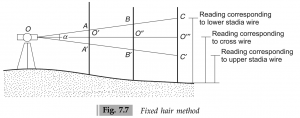Methods Of Tacheometry
Stadia method
The term stadia is a Greek word for a unit length. Originally it was applied to measuring distances for athletic contests.
In a tachometer, the various wires, in addition to the cross-wires on the diaphragm, are known as stadia wires and the vertical distance between the stadia wires is termed as stadia interval.
The method derives its name from the fact that the observations are made with respect to these wires.
However, When the parallactic angle (Fig. 7.6), defined by means of stadia wires, is kept fixed and the staff intercept is varied, e.g., AB and A B, the method is called the fixed hair method.

However, a tachometer and a staff are used to make the observations. Another way can be to keep the staff intercept fixed, e.g., AB and A B, and varying the parallactic angle, e.g., and (Fig. 7.6).
Also Read: Plane survey
In the latter case, the stadia wires will have to be moved and are accordingly known as the movable hair or subtense method.
A subtense theodolite in conjunction with a staff or subtense bar is used to make the observations.
Tangential method
In this method of the tachometer, observations are made for vertical angles and staff intercepts are obtained by the cross-wires only. Stadia wires are not used at all.
However, This method of the tachometer is similar to the method of trigonometrical leveling.
Also, watch this for a better understanding of methods of tacheometric:
Range finding
This method is used to find the horizontal distance and direction of a line without going to the far end of the line. The instrument used is known as a range finder.
Moreover, A fixed base is used to compute the ranges. The instruments and methods used are based on the measurement of either the base angles or the angle of parallax.
Also Read: Reciprocal leveling
However, In the first two methods, both the horizontal and vertical distances are obtained, but by this method, only horizontal distances can be measured.
A level can be employed, in conjunction, to measure the vertical distances.
fixed hair Method
The horizontal and vertical distance (elevation) of a point may be determined by the fixed hair (fixed stadia interval), commonly known as the stadia method.
A tachometer is kept at one point and the staff is placed on the points whose elevations, and distances from the instrument point, are to be determined.
The stadia interval is kept fixed, and consequently, the staff intercept varies (AA, BB, etc.) as shown in Fig. 7.7.
The principle of the stadia method is that “in isosceles triangles, the ratio of perpendiculars from the vertex on their bases, and the bases is constant”.
Let, OAA, OBB, and OCC be the three isosceles triangles (Fig. 7.7). Then, where K is a constant and is the parallactic angle.
Hence, if the staff intercepts AA, BB and CC are known, the horizontal distance OO, OO, and OO can be determined, provided the parallactic angle ∝ is known.

